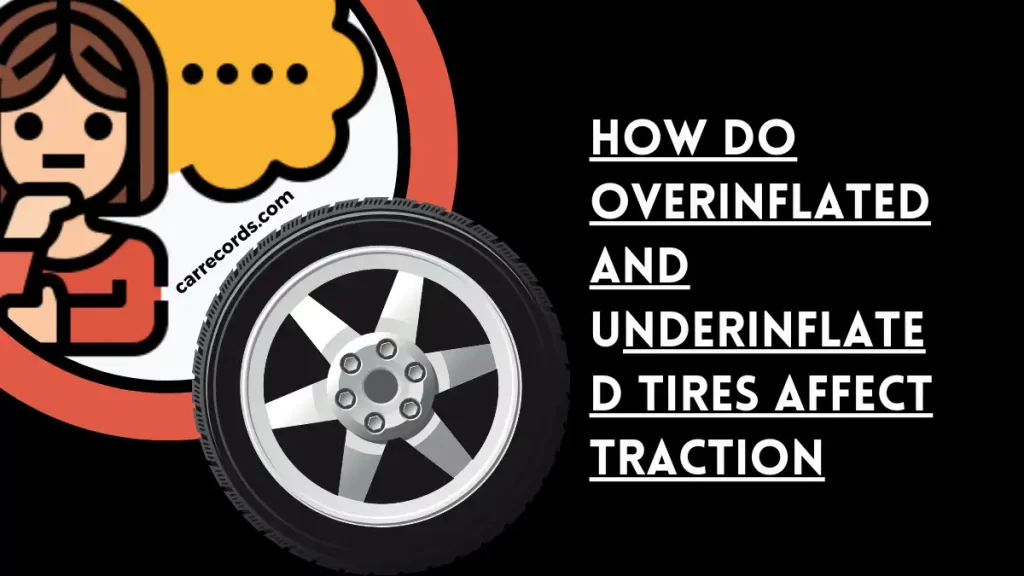✔️ How Do Overinflated and Underinflated Tires Affect Traction ?
Underinflated tires experience accelerated heating and quicker failure compared to properly inflated ones. Conversely, overinflated tires, with excessive pressure, wear down faster and exhibit reduced traction.
Traction is a critical factor that influences the safety and performance of a vehicle on the road. Achieving optimal traction is a delicate balance that involves various components of the vehicle, with tire inflation playing a pivotal role. Properly inflated tires ensure that a vehicle maintains its grip on the road, enhancing stability, maneuverability, and overall safety. However, both overinflated and underinflated tires can lead to a range of issues, including compromised traction.
The Effects of Underinflated Tires on Traction
When a tire is underinflated, it means that its pressure is lower than the recommended level for the load and driving conditions. While this might seem counterintuitive, under certain circumstances, underinflated tires can actually improve traction, particularly in off-road and challenging terrains. Let’s examine a few examples:

Example 1: Off-Road Traction
Off-road enthusiasts often reduce tire pressure when navigating through mud, sand, or rocky terrain. This deliberate underinflation increases the tire’s contact area with the ground, allowing the tread to better conform to uneven surfaces. As a result, the tire can better grip the terrain, improving traction, and preventing slipping or spinning. This technique is effective at low speeds and with vehicles that are not overloaded, as excessive weight can cause the tire sidewalls to flex excessively and potentially lead to damage.
Example 2: Overloading and Overinflation
In contrast to off-road scenarios, overloading a vehicle with underinflated tires can lead to reduced traction. When a vehicle is carrying more weight than the tire’s recommended load capacity, the tires may experience increased wear and excessive heat buildup. This can compromise the tire’s ability to grip the road surface effectively, especially during acceleration or cornering. Overinflating the tires might seem like a solution to counteract the weight, but it’s crucial to adhere to the manufacturer’s recommended inflation pressure. Overinflated tires have a smaller contact patch, which can diminish traction and negatively impact braking performance.
The Effects of Overinflated Tires on Traction
Overinflated tires, where the tire pressure exceeds the manufacturer’s recommendations, can also have a significant impact on traction and overall vehicle performance. Let’s explore the consequences of driving with overinflated tires:
Example 1: Reduced Contact Area
Overinflated tires have a smaller and more rigid contact area with the road. This reduced footprint means that there are fewer tire treads in contact with the road surface. Consequently, the available traction is compromised, particularly in wet or slippery conditions. The tire’s ability to grip the road is diminished, leading to potential skidding, reduced stability, and longer braking distances.
Example 2: Uneven Tire Wear
Excessive tire pressure can lead to uneven tire wear. Overinflated tires tend to wear down the center of the tread more quickly than the edges. This not only shortens the lifespan of the tire but also further diminishes its ability to maintain traction. Tires with uneven wear patterns are more prone to hydroplaning, which occurs when a layer of water separates the tire from the road, significantly reducing traction and control.
Optimal Inflation for Traction
Finding the right balance between overinflation and underinflation is key to maintaining optimal traction. Here’s how to achieve it:
Example 1: Following Manufacturer Recommendations
Manufacturers determine the recommended tire pressure based on extensive testing and engineering. This information is typically found on the vehicle’s door jamb or in the owner’s manual. Following these recommendations ensures that the tires are inflated to provide the best possible traction for a wide range of driving conditions.
Example 2: Adjusting for Specific Conditions
While manufacturer recommendations provide a solid baseline, adjusting tire pressure for specific conditions can further enhance traction. For instance, if you’re driving in icy or snowy conditions, slightly reducing tire pressure can increase the tire’s surface area in contact with the road, improving grip. Conversely, if you’re driving on well-paved roads, maintaining the recommended tire pressure ensures optimal handling and traction.
FAQs
Q: What are the dangers of driving with consistently underinflated tires?
A: Underinflated tires can lead to increased rolling resistance, decreased fuel efficiency, and overheating, which ultimately compromises traction and safety. They are also more susceptible to blowouts.
Q: How can overloading affect tire traction?
A: Overloading a vehicle can cause the tires to become excessively compressed, reducing their ability to grip the road. Overloaded vehicles are more prone to skidding, especially during braking or cornering.
Q: Is it safe to slightly overinflate tires for better fuel efficiency?
A: While overinflating tires might improve fuel efficiency slightly, the trade-off is compromised traction, uneven wear, and reduced ride comfort. It’s recommended to adhere to the manufacturer’s guidelines.
Q: How often should I check my tire pressure for optimal traction?
A: Regular tire pressure checks should be conducted at least once a month and before long trips. Fluctuations in temperature can cause changes in tire pressure, affecting traction.
Q: Can tire tread pattern also affect traction?
A: Absolutely. The tread pattern is designed to channel water away from the tire’s contact patch and provide grip on various surfaces. Worn-out tread can significantly reduce traction, especially in wet conditions.
Conclusion
Maintaining optimal traction is a multifaceted endeavor, and tire inflation plays a crucial role in this pursuit. Both overinflated and underinflated tires can compromise traction and vehicle performance, leading to safety hazards and reduced efficiency.
By understanding the intricate relationship between tire pressure and traction, vehicle owners can make informed decisions that enhance their driving experience. Remember, while manufacturer recommendations provide a solid foundation, adjusting tire pressure for specific driving conditions and consistently monitoring tire pressure are vital steps to ensure peak traction, stability, and safety on the road.
source : https://www.quora.com/How-do-underinflated-overinflated-and-properly-inflated-tires-affect-traction

